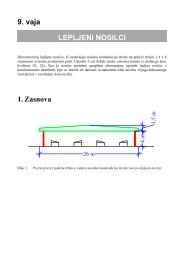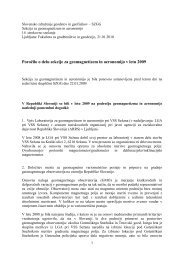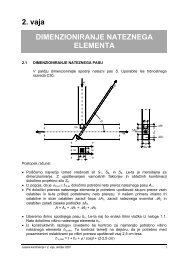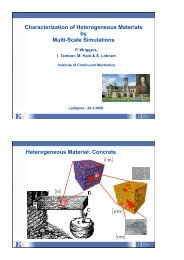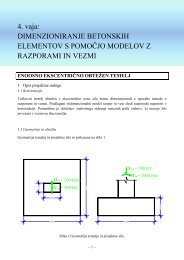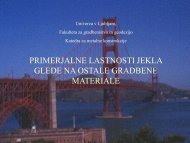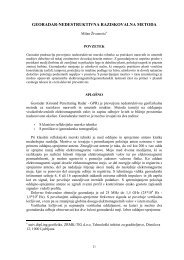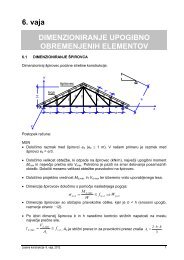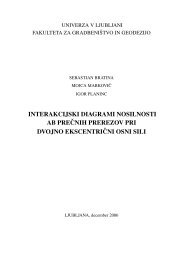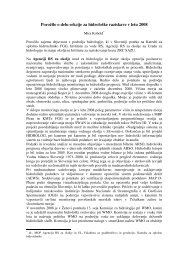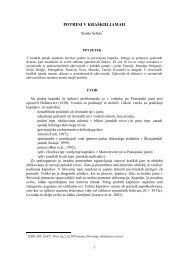- Page 4 and 5: Fundamentals of ASTRODYNAMICS ROGER
- Page 6: This textbook is dedicated to the m
- Page 9 and 10: vi asterisk (*). In addition to exe
- Page 12 and 13: CONTENTS Preface Chapter 1 TWO-BODY
- Page 14 and 15: 5.5 The Gauss Pro blem Using the f
- Page 16 and 17: CHAPTER 1 TWO-BODY ORBITAL MECHANIC
- Page 18 and 19: Sec. 1 .1 HISTORICAL BACKGROUND AND
- Page 20 and 21: Sec 1.2 THE N-BODY PROBLEM z G Mm r
- Page 22 and 23: Sec 1.2 THE N·BODY PROBLEM 7 Apply
- Page 24 and 25: Sec 1.2 THE N-BODY PROBLEM 9 F OTHE
- Page 26 and 27: Sec. 1.3 THE TWO-BODY PROBLEM 11 is
- Page 28 and 29: Sec. 1.3 THE TWO-BODY PROBLEM 13 X'
- Page 30 and 31: Sec. 1.4 CONSTANTS OF THE MOTION 15
- Page 32 and 33: Sec. 1.4 CONSTANTS OF THE MOTION 17
- Page 34 and 35: Sec. 1.5 THE TRAJECTORY EQUATION 19
- Page 36 and 37: Sec. 1.5 THE TRAJECTORY EQUATION 21
- Page 38 and 39: Sec 1.5 THE TRAJECTORY EQUATION its
- Page 40 and 41: Sec. 1.5 THE TRAJECTORY EQUATION Co
- Page 42 and 43: Sec. 1 01) RelATING TO GEOMETRY OF
- Page 44 and 45: Sec 1.6 so . tor any conic orbit, R
- Page 46 and 47: Sec. 1.7 THE ELLIPTICAL ORBIT 31 I
- Page 48 and 49: Sec. 1.8 THE CIRCULAR ORBIT 33 Equa
- Page 50 and 51: Sec. 1.9 THE PARABOLIC ORBIT 35 ---
- Page 52 and 53:
Sec. 1.9 THE PARABOLIC ORBIT 37 p =
- Page 54 and 55:
Sec. 1.10 THE HYPERBOLIC ORBIT 39 f
- Page 56 and 57:
Sec. 1.11 CANON ICAL UNITS 41 norma
- Page 58 and 59:
Sec, 1.11 CANONICAL UNITS Find h fr
- Page 60 and 61:
Ch. 1 EXERCISES 45 d. Find the leng
- Page 62 and 63:
Ch. 1 EXERCISES body and rj l< is t
- Page 64:
Ch. 1 49 LIST OF REFERENCES 1. Newm
- Page 67 and 68:
52 ORBIT DETERMINATION FROM OBSERVA
- Page 69 and 70:
54 ORBIT DETERMINATION FROM OBSERVA
- Page 71 and 72:
56 ORBIT DETERMINATION FROM OBSERVA
- Page 73 and 74:
58 ORBIT DETERMINATION FROM OBSERVA
- Page 75 and 76:
60 ORBIT DETERM INATION FROM OBSERV
- Page 77 and 78:
62 ORBIT DETERMI NATION FROM OBSERV
- Page 79 and 80:
64 ORBIT DETERMINATION FROM OBSERVA
- Page 81 and 82:
66 ORBIT DETERMINATION f ROM OBSERV
- Page 83 and 84:
68 ORBIT DETERMI NATION FROM OBSERV
- Page 85 and 86:
70 ORBIT DETERMINATION FROM OBSERVA
- Page 87 and 88:
72 ORBIT DETERMINATION FROM OBSERVA
- Page 89 and 90:
74 ORBIT DETERMINATION FROM OBSERVA
- Page 91 and 92:
76 ORBIT DETERMINATION FROM OBSERVA
- Page 93 and 94:
78 ORBIT [ DETERMINATION 0] FROM OB
- Page 95 and 96:
J 80 ORBIT DETERMINATION :::: f· F
- Page 97 and 98:
82 ORBIT DETERMINATION FROM OBSERVA
- Page 99 and 100:
84 ORBIT DETERMINATION FROM OBSERVA
- Page 101 and 102:
86 ORBIT DETERMINATION FROM OBSERVA
- Page 103 and 104:
88 ORBIT DETERMINATION FROM OBSERVA
- Page 105 and 106:
90 ORBIT DETERMI NATION FROM OBSERV
- Page 107 and 108:
92 ORBIT DETERMINATION FROM OBSERVA
- Page 109 and 110:
94 ORBIT DETERMINATION 6378.145 FRO
- Page 111 and 112:
96 ORBIT DETERMINATION FROM OBSERVA
- Page 113 and 114:
98 ORBIT DETERMINATION FROM OBSERVA
- Page 115 and 116:
100 ORBIT DETERMINATION FROM OBSERV
- Page 117 and 118:
102 ORBIT DETERMI NATION FROM OBSER
- Page 119 and 120:
104 ORBIT DETERMINATION FROM OBSERV
- Page 121 and 122:
106 ORBIT DETERMINATION FROM OBSERV
- Page 123 and 124:
108 ORBIT DETERMINATION FROM OBSERV
- Page 125 and 126:
11 0 ORBIT DETERMINATION FROM OBSER
- Page 127 and 128:
112 ORBIT DETERMINATION FROM OBSERV
- Page 129 and 130:
1 14 ORBIT DETERMINATION FROM OBSER
- Page 131 and 132:
116 ORBIT DETERMINATION FROM OBSERV
- Page 133 and 134:
1 18 ORBIT DETERMINATION FROM OBSER
- Page 135 and 136:
120 ORBIT D ETERMINATION FROM OBSER
- Page 137 and 138:
122 ORBIT DETERMINATION FROM OBSERV
- Page 139 and 140:
124 ORBIT DETERMINATION FROM OBSERV
- Page 141 and 142:
126 ORBIT DETERMINATION FROM OBSERV
- Page 143 and 144:
128 ORBIT DETERMINATION FROM OBSERV
- Page 145 and 146:
1.00 0.00 2.026 105.41 40.10 69.27
- Page 147 and 148:
132 ORBIT DETERMINATION FROM OBSERV
- Page 149 and 150:
134 ORBIT DETERMINATION FROM OBSERV
- Page 151 and 152:
136 ORBIT DETERMINATION FROM OBSERV
- Page 153 and 154:
138 ORBIT DETERMINAT ION FROM OBSER
- Page 155 and 156:
140 O RBI T DETERMINAT ION F ROM OB
- Page 157 and 158:
142 O RBIT DETERMINATI ON FRO M OBS
- Page 159 and 160:
144 ORBIT DETERMINAT ION FROM OBSER
- Page 161 and 162:
146 O RBIT DETERMINAT I ON FROM OBS
- Page 163 and 164:
148 ORBIT DETERMINATI ON F R OM OBS
- Page 165 and 166:
150 ORBIT DETERMINATION FROM OBSERV
- Page 167 and 168:
152 BASIC ORBITAL MANEUVERS Ch .3 r
- Page 169 and 170:
154 BASIC ORBITAL MANEUVERS Ch .3 o
- Page 171 and 172:
156 BASIC ORBITAL MANEUVERS Ch . 3
- Page 173 and 174:
158 25 >- 20 "' C II: "' .J 0 15 I/
- Page 175 and 176:
160 BASIC ORBITAL MANEUVERS Ch .3 3
- Page 177 and 178:
. 162 BASIC ORBITAL MANUEVERS Ch .
- Page 179 and 180:
164 BASIC ORBITAL MANEUVERS Ch . 3
- Page 181 and 182:
166 BASIC ORBITAL MANEUVERS Vcs = (
- Page 183 and 184:
t Q) I o - c CD o o CD 168 BASIC O
- Page 185 and 186:
170 BASIC ORBITAL MANEUVERS Ch. 3 F
- Page 187 and 188:
112 BASIC ORBITAL MANEUVERS and we
- Page 189 and 190:
174 BASIC ORBITAL MANEUVERS . Ch .
- Page 191 and 192:
176 BASIC ORBITAL MANEUVERS Ch . 3
- Page 193 and 194:
178 POSITION AND VELOCITY -A FUNCTI
- Page 195 and 196:
180 POSITION AND VELOCITY - A FUNCT
- Page 197 and 198:
182 POSITION AND VELOCITY - A FUNCT
- Page 199 and 200:
1 84 POSITION AND VELOCITY - A FUNC
- Page 201 and 202:
186 POSITION AND VELOCITY - A FUNCT
- Page 203 and 204:
188 POSITION AND VELOCITY -A FUNCTI
- Page 205 and 206:
190 POSITION AND VELOCITY - A FUNCT
- Page 207 and 208:
192 POSITION AND VELOCITY - A FUNCT
- Page 209 and 210:
194 POSITION AND VELOCITY - A FUNCT
- Page 211 and 212:
196 POSITION AND VELOCITY - A FUNCT
- Page 213 and 214:
198 POSITION AND VELOCITY - A FUNCT
- Page 215 and 216:
200 POSITION AND VELOCITY - A FUNCT
- Page 217 and 218:
202 POSITION AND VElOCITY - A FUNCT
- Page 219 and 220:
204 POSITION AND VELOCITY - A FUNCT
- Page 221 and 222:
206 POSITION AND VELOCITY - A FUNCT
- Page 223 and 224:
208 POSITION AND VELOCITY - A FUNCT
- Page 225 and 226:
2 10 POSITION AND VELOCITY - A FUNC
- Page 227 and 228:
212 POSITION AND VELOCITY - A FUNCT
- Page 229 and 230:
214 POSITION AND VElOCITY - A FUNCT
- Page 231 and 232:
216 POSITION AND VELOCITV-A FUNCTIO
- Page 233 and 234:
218 POSITION AND VELOCITY - A FUNCT
- Page 235 and 236:
220 POSITION AND VELOCITY-A FUNCTIO
- Page 237 and 238:
222 POSITION AND VELOCITY-A FUNCTIO
- Page 239 and 240:
224 POSITION AND VELOCITY-A FUNCTIO
- Page 241 and 242:
226 POSITION AND VELOCITY-A FUNCTIO
- Page 243 and 244:
228 ORBIT DETERMINATION FROM 2 POSI
- Page 245 and 246:
230 ORBIT DETERMINATION FROM 2 POSI
- Page 247 and 248:
232 ORBIT DETERMINATION FROM 2 POSI
- Page 249 and 250:
234 ORBIT DETERMINATION FROM 2 POSI
- Page 251 and 252:
236 ORBIT DETERMINATION FROM 2 POSI
- Page 253 and 254:
238 ORBIT DETERMINATION FROM 2 POSI
- Page 255 and 256:
240 ORBIT DETERMINATION FROM 2 POSI
- Page 257 and 258:
242 ORBIT DETERMINATION FROM 2 POSI
- Page 259 and 260:
244 ORBIT DETERMINATION FROM 2 POSI
- Page 261 and 262:
246 ORBIT DETERMINATION FROM 2 POSI
- Page 263 and 264:
248 ORBIT DETERMINATION FROM 2 POSI
- Page 265 and 266:
250 ORBIT DETERMINATION FROM 2 POSI
- Page 267 and 268:
252 ORBIT DETERMINATION FROM 2 POSI
- Page 269 and 270:
254 ORBIT DETERMINATION FROM 2 POSI
- Page 271 and 272:
256 ORBIT DETERMINATION FROM 2 POSI
- Page 273 and 274:
258 ORBIT DETERMINATION FROM 2 POSI
- Page 275 and 276:
260 ORBIT DETERMINATION FROM 2 POSI
- Page 277 and 278:
262 ORBIT DETERMINATION FROM 2 POSI
- Page 279 and 280:
264 ORBIT DETERMINATION FROM 2 POSI
- Page 281 and 282:
266 ORBIT DETERMINATION FROM 2 POSI
- Page 283 and 284:
268 ORBIT DETERMINATION FROM 2 POSI
- Page 285 and 286:
270 ORBIT DETERMINATION FROM 2 POSI
- Page 287 and 288:
272 ORBIT DETERMINATION FROM 2 POSI
- Page 289 and 290:
274 ORBIT DETERMINATION FROM 2 POSI
- Page 292 and 293:
CHAPTER 6 BALLISTIC MISSILE TRAJECT
- Page 294 and 295:
Sec. 6.2 GENERAL BALLISTIC MISSILE
- Page 296 and 297:
Sec. 6.2 GENERAL BALLISTIC MISSILE
- Page 298 and 299:
Sec. 6.2 GENERAL BALLISTIC MISSI LE
- Page 300 and 301:
Sec 6.2 GENERAL BALLISTIC MISSI LE
- Page 302 and 303:
Sec. 6.2 GENERAL BALLISTIC MISSILE
- Page 304 and 305:
Sec. 6.2 GENERAL BALLISTIC MISSILE
- Page 306 and 307:
Sec. 6.2 GENERAL BALLISTIC MISSI LE
- Page 308 and 309:
Sec:. 6.2 GENERAL BALliSTIC MISSiLE
- Page 310 and 311:
Sec. 6.2 GENERAL BALLISTIC MiSSilE
- Page 312 and 313:
Sec. 6.3 LAUNCH ING ERRORS ON RANGE
- Page 314 and 315:
Sec. 6.3 LAUNCHING ERRORS ON RANGE
- Page 316 and 317:
Sec. 6.3 LAUNCHING ERRORS ON RANGE
- Page 318 and 319:
Sec. 6.3 LAUNCHING ERRORS ON RANGE
- Page 320 and 321:
Sec. 6.3 LAUNCHING ERRORS ON RANGE
- Page 322 and 323:
Sec. 6.4 vel. of train l • , -.;:
- Page 324 and 325:
Sec. 6.4 EFFECT OF EARTH ROTATION 3
- Page 326 and 327:
Sec. 6.4 EFFECT OF EARTH ROTATION 3
- Page 328 and 329:
Sec. 6.4 . EFFECT OF EARTH ROTATION
- Page 330 and 331:
Ch. 6 EXERCISES 315 6.7 In general,
- Page 332 and 333:
Ch. 6 EXERCISES 317 6.17 A ballisti
- Page 334 and 335:
Ch. 6 EXERCISES 319 All angles and
- Page 336 and 337:
CHAPTER 7 LUNAR TRAJECTORIES Which
- Page 338 and 339:
Sec. 7.2 THE EARTH-MOON SYSTEM 323
- Page 340 and 341:
Sec. 7.2 THE EARTH-MOON SYSTEM 325
- Page 342 and 343:
Sec. 7.3 SIMPLE EARTH-MOON TRAJECTO
- Page 344 and 345:
Sec. 7.3 j 80 C/) ... " 0 .c .. E i
- Page 346 and 347:
Sec. 7.3 SIMPLE EARTH-MOON TRAJECTO
- Page 348 and 349:
Sec. 7.4 THE PATCHED-CONIC APPROXIM
- Page 350 and 351:
Sec. 1.4 TH E PATCHED-CONIC APPROXI
- Page 352 and 353:
Sec. 7.4 THE PATCH ED-CONIC APPROXI
- Page 354 and 355:
Sec. 7.4 to eorth to eorth 1', THE
- Page 356 and 357:
Sec. 7.4 THE PATCHED-CONIC APPROXIM
- Page 358 and 359:
Sec. 7.4 THE PATCHED-CONIC APPROXIM
- Page 360 and 361:
Sec. 7.5 NONCOPLANAR LUNAR TRAJECTO
- Page 362 and 363:
Sec. 7.5 NONCOPlANAR LUNAR TRAJECTO
- Page 364 and 365:
Sec. 7.5 NONCOPLANAR LUNAR TRAJECTO
- Page 366 and 367:
Sec. 7.5 NONCOPLANAR LUNAR TRAJECTO
- Page 368 and 369:
Ch. 7 EXERCISES 353 7.S It is desir
- Page 370:
Ch. 7 LIST OF REFERENCES 355 LIST O
- Page 373 and 374:
358 INTERPLANETARY TRAJECTORIES Ch.
- Page 375 and 376:
(;) 00 N N Semi-major Planet axis a
- Page 377 and 378:
362 INTERPLANETARY TRAJECTORIES Ch
- Page 379 and 380:
364 INTERPLANETARY TRAJECTORIES Ch.
- Page 381 and 382:
366 INTERPLANETARY TRAJECTORIES Ch.
- Page 383 and 384:
368 INTERPLANETARY TRAJECTORIES Ch
- Page 385 and 386:
370 INTERPLANETARY TRAJECTORIES Ch.
- Page 387 and 388:
3.72 locus of injection points INTE
- Page 389 and 390:
374 INTERPLANETARY TRAJECTORIES Ch.
- Page 391 and 392:
376 INTERPLANETARY TRAJECTORIES Ch.
- Page 393 and 394:
378 reentry corridor col l ision cr
- Page 395 and 396:
380 INTERPLANETARY TRAJECTORIES Ch.
- Page 397 and 398:
382 INTERPLANETARY TRAJ ECTO RIES C
- Page 399 and 400:
384 INTERPLANETARY TRAJECTORIES Ch.
- Page 401 and 402:
386 PERTURBATIONS Ch. 9 from the no
- Page 403 and 404:
388 PERTURBATIONS Ch. 9 of motion o
- Page 405 and 406:
390 PERTURBATIONS r¢ + 2 + riP sin
- Page 407 and 408:
392 6r bi == == a p + == a p + a p
- Page 409 and 410:
394 PERTURBATIONS Ch. 9 From equati
- Page 411 and 412:
396 PERTURBATIONS Ch. 9 This algori
- Page 413 and 414:
398 PERTURBATIONS Ch . 9 rotated 90
- Page 415 and 416:
400 PERTURBATIONS (This could also
- Page 417 and 418:
402 _ di rF w cos u dt na\/1-e 2 (9
- Page 419 and 420:
404 PERTURBATIONS Ch. 9 d"-bj d h2
- Page 421 and 422:
406 PERTURBATIONS Ch. 9 As an aside
- Page 423 and 424:
408 F = (1 -zS(z )) rr 0 • Note
- Page 425 and 426:
410 PERTURBAT IONS dx 1 ex- = - [x
- Page 427 and 428:
412 PERTURBATIONS ell. 9 in detail.
- Page 429 and 430:
414 PERTU RBATIONS Ch. 9 step-size,
- Page 431 and 432:
416 PERTURBATIONS ell. 9 beginning
- Page 433 and 434:
418 PERTURBATIONS Ch. 9 like other
- Page 435 and 436:
;' \Q - Method of Numerical Trunca
- Page 437 and 438:
422 'y = §!! = 'L ·x· oy X PERTU
- Page 439 and 440:
424 and m = vehicle PERTURBATIONS m
- Page 441 and 442:
426 PERTURBATIONS Ch. 9 9.5 Describ
- Page 444 and 445:
Geocentric Mean Equatqrial Radius,
- Page 446 and 447:
APPENDIX C VECTOR REVIEW Vector ana
- Page 448 and 449:
C.2 VECTOR OPERATIONS 433 Then C=C1
- Page 450 and 451:
C.2 VECTOR OPERATIONS 435 Icl = IAI
- Page 452 and 453:
C.3 VELOCITY 437 = A I (B 2 C3 - B3
- Page 454 and 455:
C.3 VELOCITY which, from the defini
- Page 456 and 457:
D.1 PROJECT SITE/TRACK 441 American
- Page 458 and 459:
0.3 PROJECT KEPLER 443 D.3 PROJECT
- Page 460 and 461:
0.5 PROJECT INTERCEPT 445 For troub
- Page 462 and 463:
0.5 PROJECT INTERCEPT 447 p = 186.6
- Page 464:
INDEX
- Page 467 and 468:
452 Declination, 56, 117, 271 Depar
- Page 469 and 470:
454 Noncoplanar lunar trajectories,




